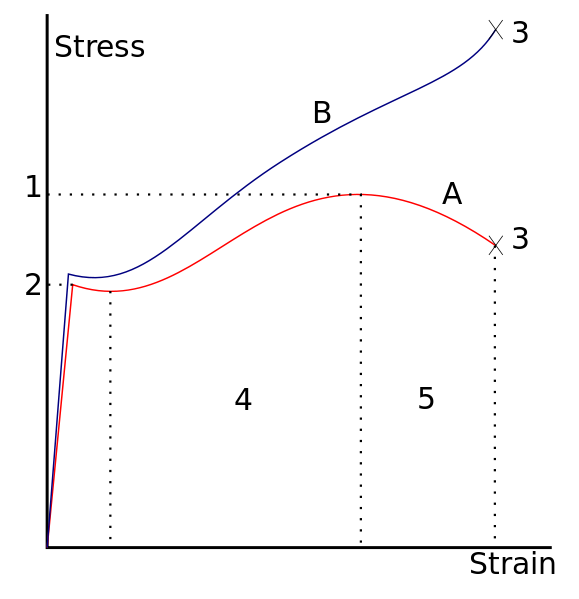-
Posts
47 -
Joined
-
Last visited
Content Type
Profiles
Forums
Events
Everything posted by Dr.Goose
-
Well they use both. The wings of fighter-aircraft are built, like most other Wings or for that matter most aircraft in general, as a semi-monocoque structure in which spares (structure) and the skin carry the load of the aircraft. (A notable modern exception is the A-10, it mostly uses the structure to carry the load, this gives it its damage resistance, because the skin can be torn off without causing structural damage.) The benefit of a semi-monocoque is it's relatively low weight and high strength (because you can downsize the structure by putting load on the skin).
-
@GGTaros The rule of thumb is, if it tells you you can do this then multiply it by the safety factor and you got the designed limitations. And a safety factor of 1.5 is plausible as it is used on other contemporary fighter aircraft. @DarkFire The graph was supposed to be generic to show the principle behind tensile strength and failure in metals. And thanks for pointing out the different behavior of high tensile strength metal. I didn't know that (as a 2. semester engineer I haven't had material science yet :music_whistling:). And I agree that repetitive stress near the maximum will subsequently lower the the strain values (I stated this in my first post ) this is the reason for airframe lifetimes. But still 14g is about 4% above the 13.5g (1.5 safety factor and 9g allowed assumed), so it still seams plausible that it wouldn't cause full structural failure at least in a younger airframe. Loads of repairs and possible warping yes but not full failure. Like the warped 11.5g F-104 I mentioned earlier. But you're free to disagree and show my why it isn't plausible or even possible.
-
Dear GGTharos No, 14g will most certainly not cause full structural failure. Summary: 1.Ultimate strength (max strength (max g)) 2.Yield strength (9g*1.5=13.5 this is what the F-15 is designed to withstand you can't argue with this, it's simple engineering) 3.Rupture (full failure) 4.strain hardening region (warping) 5.Necking region A:Apparent stress (F/A0) B:Actual stress (F/A) This is because of material science behind metal, it bends to take more stress before it breaks. I would like the source for 12.5g btw, because I read 20+ g all the time and it seams plausible due to the balancing of the stabilator. P.S. I saw a F-104 that had pulled 11.5g (7*1.5=10.5<11.5^=15g for an F-15) it had only marginal but upon further inspection clearly visible warping.
-
The F-15 is designed to withstand 13.5gs anything above and you seriously risk the possibility of warping your airframe and eventual structural failure (at higher g-loads). The 9g restriction is only to guarantee the life time of the airframe, and above 9g all bets are off, and the aircraft must undergo several tests to make sure that the aircraft has not taken any damage (such as warping or limited structural failure). Any engineer designs a safety margin in to their aircraft or for a matter of fact anything, your table that can hold 100lbs was probably designed to carry 130lbs and the 100bar tank at the oil-refinery probably 270bar. Though the structural strength is eventually compromised by fatigue, so a young aircraft can handle more than an old and brittle one (this is why airframes have designed lifetimes). So for a young F-15 the 14gs shouldn't be a big problem, they just eat lots of airframe life. But for a older and more brittle F-15, 14gs may be a serious issue with potential for a catastrophic failure. P.S. I forgot: Tthe weight of the aircraft and the weight of the stores heavily influence potential warping and failure
-
Hey Sryan You have done an incredible job. This is a MUST READ for any F-15 or general DCS beginner!!! I have learned a thing or two, too ;). Any time there's a new guy I will direct him to this guide and the pdf. It's really an incredible piece. Chapeau :thumbup:
-
Hey GeorgeLKMT I think your work so far is really awesome and I can't wait to see it on my screen. But take what ever time you need, you've done a great job till now. ;)
-

questioning F15 FM in crosswinds (track attached)
Dr.Goose replied to gamerman972's topic in F-15C for DCS World
Interesting that this topic came up. I just practiced some crosswind landings this weekend and I must say that the effects of a crosswind were just slightly higher then I would have expected. I too experienced some skidding but not the excessive (nose wheel) skidding like I saw in gamermans track. A 12knot 90°* crosswind was literally no issue using proper crab technique.** (Keep in mind that formation landings are prohibited above 10knots of crosswind and formation takeoffs at 15knots***) A 22knot 90°* cross was difficult (and well out of comfort) but again (with proper technique) doable.** Though I failed to preform a 32knot 90°* crosswind landing as I constantly tipped over on landing (even tough I used full into wind aileron)** To sum it up. This performance is not all to unexpected for an Aircraft like the F-15 as it has a fairly narrow track and a large high wind resistance body which makes it susceptible to cross winds. * 90° means a 90°+-5° relative wind to the runway (basically a pure crosswind) **this data is for a clean configurated F-15 with 5.000-12.000lbs of fuel. ***AIR FORCE INSTRUCTION 11-2F-15 Volume 3; 18 September 2014; F-15--OPERATIONS PROCEDURES; pages 15 and 28 "http://static.e-publishing.af.mil/production/1/af_a3_5/publication/afi11-2f-15v3/afi11-2f-15v3.pdf" -

Destruction of airframe due to high Gs or even speed
Dr.Goose replied to JazonXD's topic in F-15C for DCS World
The current status of the Su-27 is unrealistic (I have seen a break up at 9,4g), but the F-15 is designed to withstand up to 13,5g and has been recorded to pull up to 40g (though only for a very short time). So the next update should fix the Flanker ;) -
Hey guys thanks for hosting this event. I've signed up, but I won't be available between 15:30 and 18:30 UTC because I have to work. Dr. Goose
-

Red Flag 5 - Fight for the Right!
Dr.Goose replied to 104th_Maverick's topic in Tournaments & Events
Hey guys, does anybody else on the challenger side want to meet up on Friday to come up with a strategy??? I would suggest ca. 18:00 Zulu to meet (maybe on the 104th TS server (If that's ok 104th guys???)) Thanks Dr. Goose -
Hey Stuge I'm sorry I just got jammed up with a must show on Saturday and won't be able to be back till 20:00 UTC, so I'll have to drop out of the dogfight. I hope you guys will have lots of fun anyway Dr. Goose
-
I agree that night missions are a very good idea and in terms of weather winds would give a new depth in terms of simulation (because when are there calm winds at 10.000ft, honestly). This would put you on your heals as flying at night is always a challenge (even for an experienced aviator). And because this is a simulator, it ads realism (wars don't stop when the sun goes down and/or there's a slight breeze) But severe low altitude cloud cover would seriously hamper the air to ground folk. Not just for the reasons that King Hrothgar named, but also because it would hamper the use of targeting pods and PGMs. A compromise would be more night missions and more missions with winds and cloud cover at 20.000+ft.
-
Hey Stuge if I can still sign up, count me and my F-15 in. :D (Can't say no to a good dogfight :thumbup: )
-

Red Flag 5 - Fight for the Right!
Dr.Goose replied to 104th_Maverick's topic in Tournaments & Events
Callsign: Dr. Goose Aircraft: F-15C Nationality: Germany/USA Location: Germany Ruleset: business as usual -

Red Flag 4 Hitting the new NTTR Theater for DCS World!
Dr.Goose replied to FLANKERATOR's topic in Tournaments & Events
Thanks to the 104th for organizing this event and to Tiger for the nice briefing. I really had a lot of fun. I'm eager to join the next events ;) -

Red Flag 4 Hitting the new NTTR Theater for DCS World!
Dr.Goose replied to FLANKERATOR's topic in Tournaments & Events
Callsign: Dr. Goose Aircraft: F-15C Nationality: Germany/USA Location: Germany Availabilty: Confirmed for both dates Ruleset: Confirmed read and understood -

Top Gun Round 2 [Modern BFM competition]
Dr.Goose replied to FLANKERATOR's topic in Tournaments & Events
Hey I'm available this weekend. Dr. Goose -

Top Gun Round 2 [Modern BFM competition]
Dr.Goose replied to FLANKERATOR's topic in Tournaments & Events
-Dr. Goose -no squadron -German/(USA) -1v1 -F-15C -
Is it still open, because I'm pretty interested.


